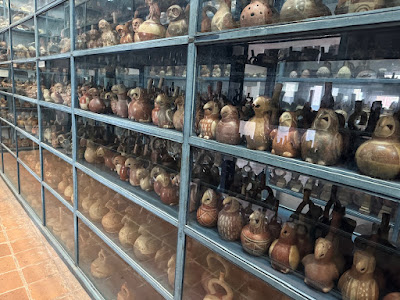Lima is a city of 11 million people divided into around 40 districts. It is also the longest city at 60 miles in length. We are 10 degrees south of the equator. Lima is a dry arid city with only 2-3 inches of rain a year but there are 50 rivers that drain the Andes and supply the city with water.
The main economy in Peru is mining (silver, gold, copper, arsenic, and lithium), fishing, farming and tourism.
Ruth took us to a rich part of the Barranco District. Barranco means cliff as it sits on the cliffs overlooking the ocean. Most of the land at the bottom of the cliffs is rock and soil that has been moved building the city. On top of that are highways, parks, beaches and many recreational areas.
Barranco is where we find art and cultured. We visited a very nice neighborhood with beautiful homes and a restaurant where we will dine tonight. We then stopped at a park with buzzard sculptures and a bridge of sighs. These are sighs of love as we held our breath when we crossed the bridge so that our wishes will come true.
We were introduced to Chanukah Granda, a famous Peruvian singer-songwriter.
Now for some history. We visited the Museo Larco. Italian archaeologists discovered a treasure of over 25,000 artifacts on a relatively small area of land. They have determined that the pottery was pre-Incan people called Moche. There is no written record, only the pottery and paintings, and a few textiles and mummies, to tell their story.
The pottery were drinking vessels and the beverage is a fermented corn drink. It is estimated that these artifacts are over 3,000 years old. One mummy they found was a 6 year old boy curled into the fetal position before being wrapped in many layers of cloth.
Jewelry was also found. They had the large hole in the ear lobe and they also wore large and elaborate nose rings. Some of the pottery was very erotic.
We again visited the Plaza Mayor but this time we entered the Cathederal of Lima. Pizzaro, a Spaniard, laid the first stone of this church in the early 1500’s but this is the 3rd building due to earthquakes. The ceiling is all wood and the organ has 5000 pipes.
We next visited the Monastery Santo Domingo, built in the 1600’s to house over 100 monks. Today there are still 30 monks living and working here. It has an extensive library and is covered in Moorish tiles from 1660.












No comments:
Post a Comment